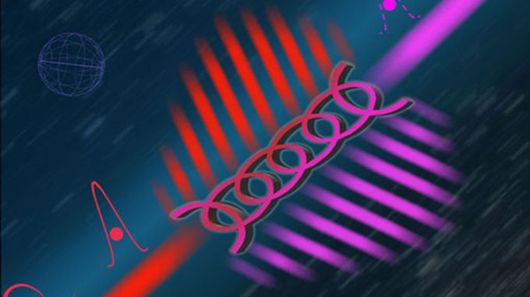
In quantum cryptography, encoding entangled photons with particular spin states is a technique that ensures data transmitted over fiber networks arrives at its destination without being intercepted or changed. However, as each entangled pair is usually only capable of being encoded with one state (generally the direction of its polarization), the amount of data carried is limited to just one quantum bit per photon. To address this limitation, researchers have now devised a way to "hyperentangle" photons that they say can increase the amount of data carried by a photon pair by as much as 32 times.
In this research, a team led by engineers from UCLA has verified that it is possible to break up and entangle photon pairs into many dimensions using properties such as the photons' energy and spin, with each extra dimension doubling the photons' data carrying capacity. Using this technique, known as "hyperentanglement", each photon pair is able to be programmed with far more data than was previously possible with standard quantum encoding methods.
To achieve this, the researchers transmitted hyperentangled photons in the form of a biphoton frequency comb (essentially a series of individual, equidistantly-arranged frequencies) that divided up the entangled photons into smaller parts. An extension of the technique of wavelength-division multiplexing (the process used to simultaneously transmit things such as multiple video signals over a single optical fiber), the biphoton frequency comb demonstrates the useful applications of such methods not just at macro levels, but quantum ones as well.
"We show that an optical frequency comb can be generated at single photon level,” said Zhenda Xie, an associate professor of electrical engineering at UCLA and research scientist on the project. "Essentially, we’re leveraging wavelength division multiplexing concepts at the quantum level."
Working on previous theories mooted by Professor Jeff Shapiro of MIT on the possibilities of quantum entanglement being utilized in the formation of comb-like properties of light, it is only with recent adaptations of ultrafast photon detectors and the advancement of the various supporting technologies required to generate hyperentanglement that such hypotheses could be physically tested.
"We are fortunate to verify a decades-old theoretical prediction by Professor Jeff Shapiro of MIT, that quantum entanglement can be observed in a comb-like state," said Chee Wei Wong, a UCLA associate professor of electrical engineering who was the research project’s principal investigator. "With the help of state-of-the-art high-speed single photon detectors at NIST and support from Dr. Franco Wong, Dr. Xie was able to verify the high-dimensional and multi-degrees-of-freedom entanglement of photons. These observations demonstrate a new fundamentally secure approach for dense information processing and communications."
If this research can be successfully and continuously replicated, quantum encoding will no longer be bound to the limitations of a single quantum bit (qubit). Rather, quantum hyperentanglement research can now move into the realm of the qudit (a unit of quantum information encoded in any number of d states, where d is a variable),where the quantum-encoded information able to be transmitted can theoretically be increased manifold times by simultaneously encoding energy levels, spin states and other parameters inherent in the quantum attributes of a photon.
Aside from the usual applications in secure communication and information processing, and high-capacity, minimal error data transfer, the team believes that a raft of other technologies could benefit from this breakthrough. The enormously data-intensive needs of medical computer servers, government information transfer, financial data, ultra-secure military communications channels, distributed quantum computing, and quantum cloud communications are just a few of the areas the researchers say may usefully employ this new method.
Engineers at UCLA were the research project’s principal investigators, with assistance provided from researchers at MIT, Columbia University, the University of Maryland, and the National Institute of Standards and Technology.

 Previous page
Previous page Back to top
Back to top







